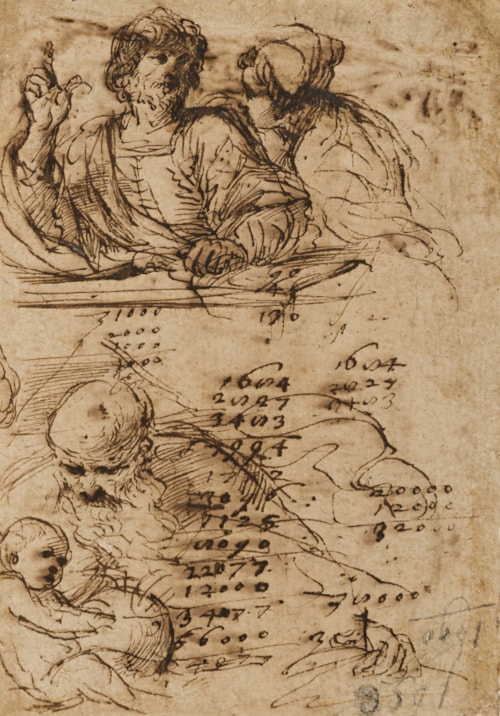
Cesare GENNARI
Cento 1637 - Bologna 1688
Biography
The nephew of Giovanni Francesco Barbieri, called Guercino - his mother Lucia Barbieri was the painter’s sister - Cesare Gennari was born in Cento into an artistic dynasty that also included his father Ercole, uncle Bartolomeo and brother Benedetto. He settled with his family in Bologna at the age of six, living in a house close to that of his uncle Guercino, whose workshop he joined, probably sometime in the early 1650s. Together with his elder brother Benedetto, Cesare was trained as a painter by Guercino, and both brothers worked as the master’s chief assistants in the last decade of his career. Their early styles as painters are often difficult to distinguish from each other, although Cesare is generally regarded as the more gifted of the two brothers. Following Guercino’s death in 1666, Cesare and Benedetto inherited the master’s studio – which came to be known as the Casa Gennari - and its contents. Following Benedetto’s move to Paris in 1672, and his later extended stay in London, Cesare chose to remain in Bologna, where he ran an art academy at the Casa Gennari.
More so than his brother, Cesare Gennari modelled his style on that of his famous uncle, and his paintings and drawings remained particularly close to the example of Guercino throughout his life. One of his first independent works was an altarpiece of The Penitent Magdalene for the high altar of the church of Santa Maria Maddalena in Cento, completed around 1662. Among other significant commissions received by the artist were a pair of large paintings depicting the story of Adonis, executed in 1665 for the Conte Alfonso II Gonzaga of Novellara and destroyed during the Second World War, and three canvases - an Annunciation, a Nativity and an Adoration of the Magi - for the Chartreuse du Val de Bénédiction in Villeneuve-les-Avignon, painted at the end of the 1660s. Other important works by the artist include a Holy Family commissioned by Cardinal Leopoldo de’ Medici in 1674, now in the Palazzo Pitti in Florence, and a Virgin and Saint Nicholas of Bari for the Bolognese church of San Nicolò degli Albari, installed there in 1680. Cesare Gennari died in Bologna in 1688, at the age of fifty, and is buried in San Nicolò degli Albari.
Cesare Gennari remains little studied as a draughtsman, and only relatively few drawings may be definitively attributed to him. It has at times proved difficult to distinguish between the drawings of Cesare and Benedetto Gennari, as both were heavily indebted to the draughtsmanship of Guercino, although it is evident that the younger brother was perhaps a more gifted draughtsman. In general, Benedetto seems to have preferred red chalk, while Cesare’s drawings are predominantly executed in pen and ink, although a number of chalk studies by him are known. An inventory of the Casa Gennari made in 1719 lists, alongside numerous drawings by Guercino, two albums of drawings by the Gennari themselves, containing 287 sheets, among which are noted a large number of landscapes by Cesare.
Of the generally accepted drawings by Cesare Gennari, among the most significant is a double-sided sheet of studies in pen and ink, formerly in the collection of Sir Denis Mahon and today in the Ashmolean Museum in Oxford. The recto of the Ashmolean drawing is a preparatory study for the artist’s altarpiece of The Virgin and Saint Nicholas of Bari of 1680 in San Nicolò degli Albari in Bologna, while the verso contains part of a letter and other sketches. Another securely attributable drawing, in the Galleria dell’Accademia in Venice, is a red chalk study for a figure in Gennari’s Adoration of the Magi in Villeneuve-les-Avignon, while a chalk drawing of the Holy Family in the Museum der Bildenden Künste in Leipzig is a preparatory study for a painting by Gennari, signed and dated 1674, in the Palazzo Pitti in Florence.
A handful of other autograph studies by Cesare Gennari are either signed or dated in his hand, or are drawn on letters written by him or addressed to him. That the artist’s drawing style was heavily indebted to that of Guercino is readily seen in all of his studies, even in such whimsical drawings as a Caricature of a Cook, inscribed (or signed) and dated 1671, in the Princeton University Art Museum in New Jersey. Other drawings by or attributed to the artist are in the collections of the Pinacoteca Nazionale in Bologna, the Harvard University Art Museums in Cambridge (MA), the Hessisches Landesmuseum in Darmstadt, the Uffizi in Florence, the Louvre in Paris, the Fondazione Giorgio Cini in Venice, and elsewhere.


